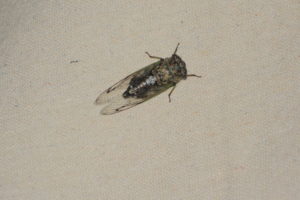Cicada – 7/31/23
Observer: Marshall Katler
Observation Date: 7/31/23
Observation TIme: 6:30 p.m.
Observation Location: Mansfield St.
Common Name: Cicada (a.k.a. Dogday Cicada)
Scientific Name: Neotibicen canicularis
Comments: This cicada was just hanging onto a sheet hung outside. It was there from at least late morning to 8:30 PM and longer. It was not there in the morning. It barely moved the entire time it was observed.
One genus of cicadas, the periodical cicadas, spend most of their lives as underground nymphs, emerging only after 13 or 17 years. The unusual duration and timing of their emergence may reduce the number of cicadas lost to predation, both by making them a less reliably available prey (so that any predator who evolved to depend on cicadas for sustenance might starve waiting for their emergence), and by emerging in such huge numbers that they will satiate any remaining predators before losing enough of their number to threaten their survival as a species.
The annual cicadas are species that emerge every year. Though these cicadas have lifecycles that can vary from one to nine or more years as underground larvae, their emergence above ground as adults is not synchronized, so some members of each species appear every year.
Cicadas have been featured in literature since the time of Homer’s Iliad, and as motifs in art from the Chinese Shang dynasty. They have also been used in myth and folklore as symbols of carefree living and immortality. The cicada is also mentioned in Hesiod’s Shield (ll.393–394), its voice sings when millet first ripens. Cicadas are eaten by human beings in various countries, including China, where the nymphs are served deep-fried in Shandong cuisine.
More Information: bugguide.net and Wikipedia

